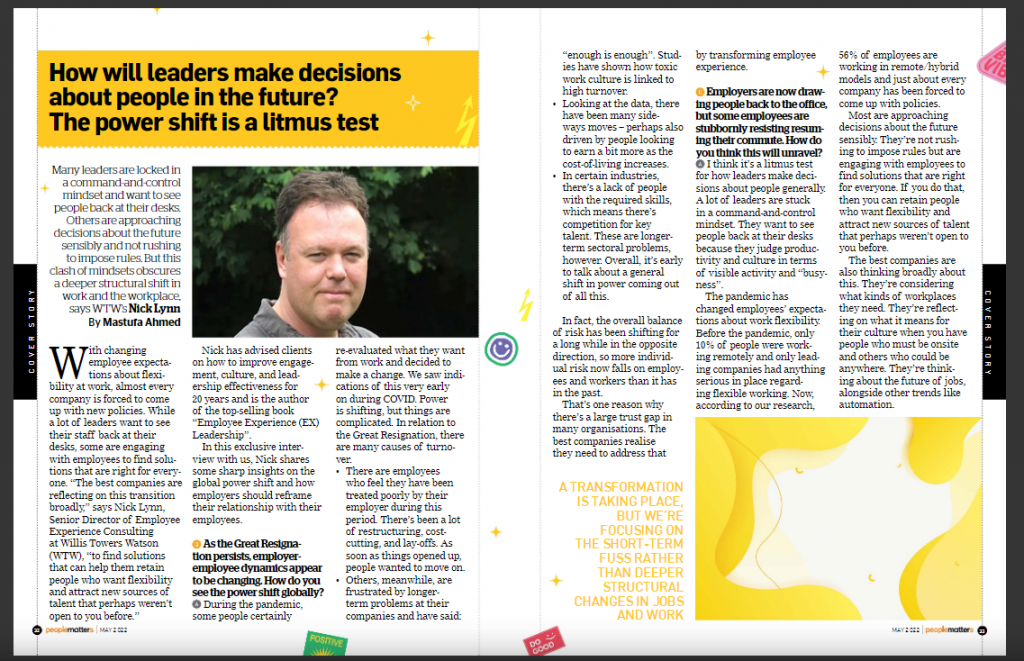You can read a long interview I did with People Matters magazine here:

Nick Lynn PhD

Here’s the latest version of my informal newsletter, containing a short selection of the very best EX articles I’ve come across over the last few months (so you don’t have to slog through LI or Twitter).
First up is a terrific HBR article by Diane Gherson and Lynda Gratton on how overwhelmed many managers are and what to do about it. In our data we’re seeing more and more evidence of manager burnout. It’s often a systemic problem that’s fixed by rethinking the role of people leader. There is some great advice in this piece: building people leadership skills, simplifying work, and job redesign. Related to this, I am working on a number of “Manager 180s” for clients at the moment that provide tailored developmental feedback to people leaders at all levels. It’s a great use of our listening platform (and often not part of a traditional “listening strategy”).
https://hbr.org/2022/03/managers-cant-do-it-all
I’m a long-time fan of Joe Pine and Jim Gilmore, the authors of The Experience Economy, one of my favourite books. I really like their latest article on transforming jobs to create more compelling employee experiences. Too much of the discussion about the Future of Work focuses on automation, cost-saving, and efficiency (the transactional side of work). It’s good to be reminded of the opportunity to invest in people, engagement, and trust (by transforming jobs).
This is an interesting article by Ayelet Fishbach on how moderate emotional discomfort can be a signal that you’re developing as a person. It often happens before you can actually detect the benefits of self-growth. In other words, short-term discomfort can be a sign you’re making progress towards long-term gains. Ayelet is author of the book “Get It Done: Surprising Lessons from the Science of Motivation”.
The final pair of articles are both reflections on what has happened over the last 2-3 years:
Here, Eric McNulty focuses on leadership. He sets out a simple process of “sensing-responding-adapting” in order to be agile enough to respond to uncertainty and shocks. I think it’s a very powerful (and simple) framework:
And here Gethin Nadin asks how you design employee experiences starting from the premise of needing “more conscious and compassionate workplaces”:
https://www.hrzone.com/engage/employees/employee-experience-and-the-rise-of-compassionate-capitalism
As always, let me know what you think!
Nick

I’m helping several companies at the moment review employee feedback from surveys and virtual focus groups and the like. On top of everything else, there are a couple of clear issues leaders are facing:
First, an innovation challenge. That might sound odd, given all the change & disruption of the last 18+ months. But a lot of those things were already in the works – they’ve mainly been accelerated. Breakthrough and disruptive innovation, which rely on collaboration and risk-taking, have been far harder to achieve. I think this is mainly due to organisations operating in a Survive State. There has been a narrowing of focus as a result. A key question for leaders is how to return to a more open innovation mindset and quickly.

Second, a growing wellbeing concern. This is not a surprise, but the sustained slog of the pandemic really is taking a toll on all aspects of wellbeing: physical, social, emotional. As a result, some people have reconsidered their working life priorities. This re-evaluation combined with sustained anxiety is one of the dynamics behind the high turnover many companies are facing. Putting deep and culture-based strategies in place to address wellbeing challenges is critical in order to support people and minimise the risk of losing key talent.


Here is the autumn edition of my EX Newsletter.
Over the last few months, we have been doing a lot of work on the connection between culture and EX, and that’s reflected in the content below. Both topics are top of mind for many leaders I’m working with. I think this is because there are just so many things happening that are impacting trust at work – witness “The Great Resignation” – that it’s important to reflect on key principles about purpose and alignment.
John Kotter’s new book Change is one of my favourites of the year and I highly recommend it. He incorporates research from neuroscience with his long-standing focus on organisational culture and change. This article is a useful summary of his approach: https://sloanreview.mit.edu/article/overcoming-obstacles-to-successful-culture-change/
I like this idea of “a people-centered operating system” from Vivek Sharma, with a focus on goal setting, learning, and culture. In this short article, he argues that the future of work is really about the future of talent, which is something I strongly agree with: https://www.entrepreneur.com/article/376749
I am very interested in new and different sources of EX data, so Culture X’s research into Glassdoor reviews is something I’ve been following closely. This is another great article from them, which highlights the fundamental importance of respect and leadership: https://sloanreview.mit.edu/article/10-things-your-corporate-culture-needs-to-get-right/#EmployeeExperience
My colleague John Bremen has written a series of terrific articles on human capital issues and I really enjoyed this one on “workplace dignity”. He talks about dignity at work, dignity in work, and dignity from work: https://www.willistowerswatson.com/en-GB/Insights/2021/09/reducing-talent-risk-through-workplace-dignity
I hope you find these articles useful; let me know!
Nick
Here is the Summer edition of my EX newsletter; a selection of the key EX articles I’ve come across over the last few months.

Why Trust Is the Future of the Employee Experience
So much has been written about EX and making hybrid working work! But I really like this short and optimistic article by Gethin Nadin. “One of the biggest lessons businesses learned from the pandemic was that employees can be trusted. As we begin to recover and prepare for new ways of working, it’s critical for employers to sustain this trust and build an employee experience founded on autonomy and choice.”
https://www.hrzone.com/engage/employees/why-trust-is-the-future-of-the-employee-experience
Should HR Adopt the “Noise Audit”?
Daniel Kahneman’s new book Noise (about the variability of human judgement) has been getting a lot of press. In this short LI piece, Anna Tavis asks “What does it mean for HR?” and concludes “We may consider adding the “noise audit” to our organizational tool kit and revisit our relationship with algorithms as partners on the people experience journey.”
https://www.linkedin.com/pulse/should-hr-adopt-noise-audit-anna-a-tavis-ph-d/
The Pandemic Did Not Affect Mental Health the Way You Think
This was a really interesting article in The Atlantic. The pandemic has led to real struggles for many people and many companies (also see below), but at the same time there has been an astonishing degree of resilience, which in itself holds key lessons.
The Great EX Stress Test
We have been busy with new WTW research. We have just published the results of a major external survey of employee experience. The pandemic has put many organisations under stress and we have looked at those companies that have been able to respond the best, because they have a transformative approach to EX. I have put some of our slides here if you’d like to see them (hot off the press!)
https://www.linkedin.com/smart-links/AQGVP983fY2w3w
I have also written a couple of articles recently: The first is about how UK companies have responded to the FRC changes on board oversight of employee engagement. The second is on why co-creation and involvement are at the heart of EX activation.
https://exleadership.com/employee-engagement/
https://exleadership.com/co-creating-your-employee-experience-strategy/
Any questions or comments or feedback, drop me a note!
Take care,
Nick

Hello!
A number of people have asked me to start an informal EX newsletter containing the key articles that I come across. I post and share a lot, but social media can feel like overload, and I was asked if I can provide a kind of filter. So every couple of months I plan to share 3-4 recommended articles. I will share the ones that contain really great insights or new thinking.
EX Newsletter 1st March 2021
Why you should apply design thinking to the employee experience
This article contains a great list of principles for how you think about designing EX: Segments, promises, innovation, coherence, and efficiency. “COVID-19 has forced changes in the way people work and created a once-in-a-generation opportunity to increase engagement and productivity.”
New Context, New Leadership: The 5Cs
This is one of the best articles I’ve seen on the changing context for leadership during and coming out of this pandemic. “A new Leadership permeated with Care, Cause, Collaboration, Creativity and Courage.”
When Employees Speak Up, Companies Win
This is an excellent article on speaking up. One of the things I write about in my book is how many employees “default to silence”. You have to work hard to capture employee voice. When you do, as this paper shows, everyone can win.
What is Employee Experience (EX)?
ICYMI, I have also included a link to one of my most popular blogs. I think the reason it’s popular is that everyone’s talking about EX, but there are a lot of different meanings. So I attempt to provide a definition.
——————————————————–
That’s all for this edition. If you have feedback or if there are specific EX topics you’re interested in and would like me to look out for, let me know.
Best wishes,
Nick
Tags: #EmployeeExperience #Leadership

I don’t normally share quotes, but here are two of my favourites. Both get at the importance of learning and perspective. This is why I like them:
John Wooden
“It’s what you learn when you know it all that counts.”
This is a quote from John Wooden, the American basketball player and coach. As head coach for the UCLA Bruins, he won ten national championships. Unlike most sports quote this one is humble. It acts as a reminder that even if you have great scores and results, there’s always much more you can learn. For me that’s a hallmark of a high performance culture and great leadership.
Albert Einstein, maybe
“We cannot solve our problems with the same level of thinking that created them.”
OK, so Einstein might not have said this (there’s no clear source), but the quote highlights a problem that I come across all the time in my work. You can call it denial, obfuscation, wilful blindness, etc. It gets at the need to take a different perspective. A key way to break out of this leadership trap is to capture different voices and to involve people in solutions and changes. This is at the heart of EX.
Tags: #HighPerformance #Leadership

Purpose is high on the agenda for many business leaders. As has been widely reported, for example, even the Business Roundtable group of CEOs has started to talk about organisational purpose and values. This replaces their long-held convention of “shareholder primacy” and is seen as a big shift in thinking.
In part, this is a reaction to low trust and confidence, especially in the long wake of the financial crash and numerous corporate scandals. Many people also worry that in the future, with trends such as cognitive automation and further globalisation, the trust gap that is already prevalent in many companies is only likely to worsen,
Surveying the scene, CEOs like Alex Gorsky of Johnson & Johnson point out that “People are asking questions about how well capitalism is serving society.” IBM CEO Ginni Rometty observes that “It’s a question of whether society trusts you or not. We need society to accept what it is that we do.”
Over time, we will see if this is more than a marketing campaign by this group. I hope it is, because in my experience the best companies do have a focus on creating purpose and meaning at work. In those companies, this is achieved through sustained, practical efforts, rather than by mission statements and the like. And they accelerate progress by adopting an Employee Experience (EX) lens.
“The best companies have a practical focus on creating purpose and meaning at work”
First though, a bit of background. One reason CEOs have been persuaded to talk about purpose and values is because of a wave of research in psychology, neuroscience and behavioural economics over the last decade on motivation, emotion and experience.
For example, Barry Schwartz, in his book Why We Work, showed that people get a sense of fulfilment from the work challenge, from social interaction, and from having some control over what they do. Another important factor is finding that what you do is meaningful. One important way of finding meaning is by linking what you do in your job to the welfare of others.
In some professions, such as healthcare or teaching, which are often thought of as vocations, that link to the welfare of others is clear and obvious. But in many jobs it isn’t. So effective leaders inspire employees by making it clear how their job affects others in positive ways.
A common way of doing this is by building a very clear line of sight to the experience of customers. Another way of doing this is by building a strong link to the organisation’s broader mission and vision.
This is a connection that many other authors have highlighted. From the viewpoint of behavioural economics, for example, Dan Ariely in his book Payoff highlights the complexity of motivation, suggesting that if you wrote down an equation to capture why you work, it would involve a very long list of factors, including money, achievement, happiness, a sense of progress, security, legacy, status, and so on.
Ariely criticises many organisations for being stuck in “a factory mode of production” when it comes to thinking about motivation. By this he means that leaders focus on financial rewards, whilst they neglect fundamental social elements such as identity, goodwill, connection and meaning.
Another person who has had a big impact is Daniel Pink. His best-selling book Drive was first published in 2009. In it, he highlights the importance of mastery and purpose in motivating people to perform at their best, which he characterises as a state of flow.
More specifically, he argues that it is the pursuit of mastery that is the most important thing. Pursuit is really a mindset focused on continuous improvement and perseverance towards long-term goals.
Accordingly, when it comes to inspiring leadership, organisations need to focus on what he calls “purpose maximisation”. Successful companies do not chase profit while trying to stay ethical and values-based. Their goal is to pursue purpose and to use profit as the catalyst rather than the objective.
Daniel Pink sets out an evolution in terms of organisations’ focus on motivation, from carrot and stick approaches, to performance-contingent rewards, which is where most organisations still are today, and on to what he calls Motivation 3.0: “The science shows that the secret to high performance isn’t our biological drive or our reward-and-punishment drive, but our third drive – our deep-seated desire to direct our own lives, to extend and expand our abilities, and to live a life of purpose.”
Daniel Pink notes, rather sadly, that the gap between what science knows and what business does is wide and it is not narrowing.
You can see this in the data collected in employee surveys. Most companies have a long way to go. In the UK, for example, only 56 per cent of employees say that leaders provide a vision for their company that is inspiring.
Narrowing the gap is where employee experience leadership (EX Leadership) really comes into play. A key dimension of EX leadership relates to providing purpose and meaning for people at work.
Of course, it’s one thing to point out that purpose matters to people and performance. What differentiates the best companies is that they actually do something about it. That practical application is increasingly achieved by adopting an EX lens.
Overall, the best companies are framing organisational performance in terms of individual experiences. They use EX analytics to ensure they are doing a number of important things well. From an EX point of view, a focus on purpose is actually quite practical and applied.
“From an EX point of view, a focus on Purpose is practical and applied”
For example, when it comes to thinking about jobs, tasks and roles, EX leaders have a focus on encouraging what is sometimes called job crafting.
In job crafting, managers and team leaders are able to provide employees with the authority and space to alter their jobs in such a way as to better suit their skills and interests. Employees are able to make small, but meaningful changes to the scope of their work, and to focus especially on the purpose of their role.
As described by Justin Berg, Jane Dutton, and Amy Wrzesniewski: “Within a formally designated job, employees are often motivated to customise their jobs to better fit their motives, strengths, and passions. Job crafting is a means of describing the ways in which employees utilise opportunities to customise their jobs by actively changing their tasks and interactions with others at work.”
This might mean people taking on more or fewer or different tasks, expanding or reducing the scope of tasks, or changing how they perform tasks and how they interact with others. This can happen in a wide range of work environments. Approaches like Lean and Kaizen, which I would argue have a similar emphasis on empowering operators, have transformed sectors like automotive manufacturing, for example.
It’s also the case that job-crafting is going to become an even more important capability in the future. This is because many companies are looking at the mix of skills and the “skills architecture” that they will need in order to for individuals and teams to continue to be successful in the future of work. For sure, as they undergo digital transformation, they are going to require flexibility and adaptability in crafting purposeful jobs.
“Companies are increasingly focused on the skills mix they will need in the future of work, which makes job crafting even more important”
Another element in providing meaning and purpose is by ensuring there is a clear alignment between employee experience and customer experience (EX and CX).
For all organisations, your employee experience is critical for delivering outstanding customer experiences. Put plainly, it’s not possible to provide a simple and effective customer experience if your internal tools are clunky and hard to use. You’re not going to achieve customer delight if the people dealing with your customers are disengaged. It’s impossible to deliver great service if your employees are unable to exercise their own judgement effectively.
A successful customer experience strategy is the result of your company’s culture and ways of working. How you interact internally within your company will have an impact on external interactions too. As a result, leading companies realise that they have to focus on employees when they try to improve their customer experience.
A positive customer experience is, of course, the responsibility of everyone in the company. But an EX lens can be deployed the most effectively at the points of intersection with your customers: sales reps, success managers, call centres, front-line and field staff, and so on.
“An EX lens can be deployed most effectively at the points of intersection with your customers”
In practice, this can mean linking EX and CX feedback and analytics in order to identify important differences and gaps, and then addressing them.
The single best way to improve both EX and CX is to improve the flow of knowledge. Too often, critical knowledge becomes stuck inside different departments and teams, which act as silos. A key task of EX leadership is to identify and then break these silos apart in order to ensure that information is available to all who need it. This is also a key component in simplifying the way people work and in thinking end-to-end.
EX leadership, then, involves providing a clear sense of purpose through things like job crafting and EX-CX alignment. Of course, this is one leadership component, alongside other things like team learning and personalising communications. Moreover, a critical factor is leaders’ own behaviour and consistency. Doing what you say, builds trust and confidence over time.
Ultimately, that will be the biggest test for the Business Roundtable. In a few years’ time, when people look back at their 2019 Statement on the Purpose of a Corporation, will it be seen as yet more spin? Or will these leaders have demonstrated their own sustained and practical commitment to delivering positive experiences in the organisations they lead?
Connect with me here and on twitter @nickl4 and let me know what you think.
For more on EX Leadership, you can read my book: Employee Experience (EX) Leadership: Build trust through employee experience and engagement.
The CEO quotes and information on the Business Roundtable come from the 19 August 2019 Fortune article by Alan Murray “New Purpose for the Corporation” which you can find here.
The UK employee survey data here comes from The Global Workforce Study by Willis Towers Watson.
On job crafting, see: Wrzesniewski, A., LoBuglio, N., Dutton, J. and Berg, J. (2013), “Job Crafting and Cultivating Positive Meaning and Identity in Work”, Bakker, A. (Ed.) Advances in Positive Organizational Psychology (Advances in Positive Organizational Psychology, Vol. 1), Emerald Group Publishing Limited, Bingley.
Tags: #Leadership #Purpose #FutureOfWork
This article was first published on LinkedIn on August 28, 2019

Many companies are looking at how they can transform traditional jobs through a combination of technology and new work arrangements. This is often referred to as the Future of Work.
Beyond things like robotic process automation and the increasing use of gig workers, companies are particularly interested in using Artificial Intelligence (AI) to accelerate cognitive automation. There’s a great potential for cost savings, improved efficiency and (hopefully) augmented performance.
This shift is already having an impact. Some observers, such as Richard Baldwin, for example, claim you can see a “hollowing out” of organisations as a result of this new wave of white-collar automation. New technology has always transformed work, of course. What’s different this time is that job displacement is moving far ahead of job replacement. Indeed, it’s the speed of this current digital transformation that’s the most striking aspect.
I have argued elsewhere that employees’ concerns over automation are adding to an already problematic “trust gap” that exists in many organisations. Low trust is a serious drag on performance. The best companies realise this is a critical issue and are addressing it quickly through new tools and approaches.
Unfortunately, some Future of Work thinking seems to start and finish with an old-fashioned top-down view of the workplace. It can feel like a C-Suite analysis of opportunities for saving money and improving productivity deep down in the guts of the organisation.
Looking ahead, perhaps those at the very top of the house need to reflect a bit more on their role in the future. Because if there’s one job that’s surely ripe for automation, it is the Chief Executive Officer.
Let’s imagine that a bit more… what will it mean to have an AI CEO?
Clearly, there will be some immediate and tangible benefits. For example, getting rid of your current CEO is going to shave a lot of dollars from your payroll. Human CEOs earn a lot.
How much do they get paid? According to the Economic Policy Institute (EPI) in the USA, the average pay of CEOs in large companies is $17.2 million. In the UK, the CIPD puts the mean salary for FTSE 100 CEOs at £5.7 million.
CEO compensation is also very high relative to the rest of the workforce. The EPI puts CEO pay vs. a “typical worker” at a ratio of 278-to-1. In the UK, the amount of time it takes a chief executive to earn the annual wage of an “average worker” is just 2½ days.
Replacing your CEO with technology will also help with things like gender and BAME pay gaps. This is because these very well-paid execs are overwhelmingly male and white.
Only six of the FTSE 100 CEOs (at the present time) are women. And as one of my favourite headlines of 2019 put it: “FTSE 100 has more CEOs called Steve than from ethnic minorities, research finds.”
On top of these salary considerations, there are other important factors.
Due to processing power, an AI CEO has some big advantages. No human CEO can compete with AI when it comes to strategy formulation, for instance. An AI could play out, test and learn from hundreds of competitive scenarios and simulations in the time it takes your human chief executive to adjust the recline setting on their comfortable desk chair.
In a similar vein, when it comes to responding to issues, an AI CEO is always on, always focused, 24 by 7, 365 days of the year. The AI is able to make adjustments in a blink of an eye. They can keep the business ticking over and operating efficiently anywhere in the world at any time.
Moreover, with deep learning and advanced neural processing, the AI CEO will be able to avoid predictable problems in the first place. They can also ensure that resources are available for effective risk management.
And there’s no need to provide perks as recompense for all this attentiveness and hard work. No need for golf-club membership or gym fees. No need for expensive retreats. You can sell the company jet to a pop star and forget about buying lift passes at Davos.
OK, you might think, but what about the organisational and people side of things?
Even though your CEO’s people skills may be lacking, they’re still likely to be better than a machine, right?
So how could an AI compensate?
Well, there are some things that an AI might actually do better. Think about cascading goals, creating alignment and objective setting, and then managing performance through observable, quantitative data. This is something that technology is already helping with. It could be done even more effectively by a machine leader. For instance, the AI CEO isn’t going to be bothered that the Head of Sales is a “great person” and a super “culture fit” if the sales campaign isn’t quanitifably successful and delivering positive results.
And when it comes to the ongoing monitoring of the health or fitness of the organisation, a mathematical approach can have some benefits. Imagine that you have some hierarchical redundancy in the finance function — now that the AI has brought its robot CFO cousin online. The machine CEO is going to be pretty effective at trimming non-essential people in order to keep costs down.
At the present time, there’s often little empathy from leaders when organisations undergo restructuring. At least with an AI CEO, I expect these human resources will be fired by an app in order to provide a consumer-grade experience as they exit the organisation.
The AI CEO probably doesn’t have to worry too much about culture and engagement either. Both of these things are major challenges for human executives. It’s difficult, with traditional leadership approaches, to get people to work simply, effectively and collaboratively. And it’s hard to provide the conditions whereby people are motivated to go the extra mile and inspired to bring their best ideas and efforts to all aspects of their work.
Research shows that human CEOs spend most of their time (up to 72%) bogged down in meetings, mainly in their corporate headquarters, as they try to stay in the loop and get people to do what they need them to do.
Instead of all this, the AI CEO will probably adopt a surveillance approach instead. They can monitor all digital communications and workflows as they happen. They can keep a real-time watch on productivity and collaboration by examining the “digital exhaust” trails of email, messaging and calendar data (alongside business and operational data). They can analyse the flow of information across their human networks and simply remove people who are working in silos (“low-influence nodes”). They can automatically deploy a “nudge” to their human colleagues who are failing to do exactly what’s required.
In order to fully optimise human performance, the AI might also want to assess the mood of its human colleagues. Rather than walking around, the AI can simply listen to the water-cooler gossip via the smart badges people wear. They can review the tone of meeting discussions through mics in conference rooms. They can obviously use facial recognition algorithms to analyse interactions caught on video. Of course, they can track what people are posting on social media as well. The AI leader can then add all this mood data to its retention algorithm, so that it can predict individual turnover and take action accordingly.
There are obviously some privacy concerns about this sort of surveillance (although most of this tech already exists). So there’s probably a need to ensure that the AI CEO’s algorithms follow some kind of ethical code, especially when it comes to managing people.
High ethical standards have been hard to achieve with human CEOs, of course. It might actually be easier in this new AI-led workscape.
It’s possible to imagine, for example, “hard wiring” an AI version of a doctor’s Hippocratic Oath or Isaac Asimov’s first Law of Robotics into machine leadership. This could provide consistency, reliability and even help to build trust.
Think of all the financial and non-financial scandals that can be avoided by having a piece of machinery as the boss. Plus the lawyers’ fees you’re going to save as a result.
Don’t forget all the business school tuition fees you no longer have to pay for leadership development. The AI CEO could be the final nail in the coffin of MBAs.
There are numerous other benefits, such as not stressing about succession planning and no longer paying for head-hunters. In fact, do you even need a HR department in this new world of data and analytics?
For any human CEOs actually reading this post, I apologise if it is causing your blood pressure to rise.
Let me provide some reassurance.
As your job is transformed, we will make sure that you are up-skilled to play a new role in the new organisation.
I can see, for example, you operating as a kind of Human Corporate Mascot. This could be a new future of work job title that didn’t even exist a few years ago. It involves talking to customers and investors about our vision and our values. An endless roadshow of presentations and dinners — not so unlike now really.
We will give you access to online micro-training, so you can learn to tell funnier anecdotes and we will make sure that the uniform fits.
We will need to be fair in this transition process, however. This means sending you to an assessment centre, so we can measure your current skill level and also your future potential in telling entertaining stories. And it is possible that Brenda in Accounts, whose job is also terminating, has more passion for our customers and is better suited to the ambassador role than you are.
If anyone else doesn’t like the picture presented here, then you might need to act quickly. All these trends are already apparent. Publications such as The Economist worry that capitalism is embarking on a new era of “Digital Taylorism”. Worrying about some of these trends, groups like the Business Roundtable of CEOs are trying to redefine their role and the purpose of corporations in the new world of work.
So how might you lead a different kind of organisation and still be successful in this new machine age?
Well, I would argue that a different leadership perspective is required, one that taps into the human intelligence of your workforce. One where employees and their experiences are at the heart of your thinking.
Some organisations are already making great progress in this, but many more have barely started their employee experience (EX) journey.
When I think about employee experience leadership like this, three things stand out:
You can read more about EX leadership in my book. I have looked at how the best companies are using technology and data to create better workplaces. In particular, I have looked at the critical role that leaders play in shaping employee experience, building trust and improving engagement.
Please also connect with me here and on twitter and on LinkedIn to ask me questions and to find out more.
Notes:
Obviously, this is all a bit tongue-in-cheek, but the article that got me thinking along these lines is this OneZero piece by Erin Marie Miller: https://onezero.medium.com/how-robot-ceos-could-save-capitalism-e410a33b1405
Also, I am hereby trademarking the term “Human Corporate Mascot” as I think it’s got legs. 🙂
Tags: #FutureOfWork #Leadership
This article was first published on Medium on September 7, 2019

It’s hard to lead any large organisation. Putting aside the business challenges that come with size and scale, it’s simply difficult to stay in touch with what’s happening on the ground.
(This is the first chapter from my book Employee Experience (EX) Leadership, which is available on Amazon now.)
As a senior leader, it’s all too easy to become remote and detached. A close circle of assistants manage who you meet with. You spend most of your time with a cadre of other senior people who know it’s in their interest to present things in an agreeable fashion.
It’s difficult for your communications to have an impact. The things you say are filtered through layers of management. Like Chinese whispers, they have been thoroughly distorted by the time they reach the front line. This often reinforces your remoteness in the eyes of employees, who think you don’t understand the day-to-day challenges they face.
Even if you make an effort to get out and about, your people know how to manage appearances to their advantage. You may sometimes smell the fresh paint in the lunch room when you make a site visit. That friendly employee group you met with was perhaps designed to achieve that effect.
In order to keep the organisation focused you reach out for help. The management consultants you hire are happy to give advice on how to restructure and transform your business units. Consultants are temporary partners with a focus on short-term outcomes linked to project goals. They will quickly move on to their next assignment. But long-term employees, with valuable customer insights and an understanding of work challenges, can feel overlooked and ignored. They may feel their experience is not valued as a result.
These organisational transformations come in regular waves and with soundbite names. This language is then incorporated into internal communications. This leads to employees feeling even more remote, as they’re not up to speed on the latest jargon. Again, it appears as though senior management have locked themselves into an ivory tower of their own making.
None of these problems are new. They are inherent in any large organisation. Senior leaders have recognised these problems and tried to build solutions, so they don’t end up falling victim to their own hubris.
In order to avoid this leadership trap, companies have invested in building trust through open and effective upward communications. Beyond other channels that may exist — such as hot lines, employee directors, unions and works councils — you need to keep an ear to the ground and ensure that you receive honest, unfiltered feedback. You need to be able to cut through the layers directly. You need to make sure that it’s safe for people to speak up.
As a senior leader, you need to be able to cut through the organisation’s layers directly. You need to make sure that it’s safe for people to speak up.
Over time, various devices have been put in place to make this happen. In the 1970s and 1980s, large companies began to routinely run employee surveys. These quantified employee satisfaction and allowed leaders to identify problem issues and hot spots.
In the 1990s and 2000s, surveys became fully-fledged engagement programmes, which provided all people managers with anonymous upward feedback. These survey activities were supplemented with things like focus groups, town halls, jams, open mic sessions, and so on.
This book looks at the rise and development of these approaches in detail. It takes the long view on employee surveys, climate surveys and employee engagement. It highlights some of the problems with these programmes and it pulls out the key success factors by looking at companies that do them well.
The best leaders have deployed these approaches effectively. They ask tough questions. They analyse the results in detail. They act on the feedback. They keep tabs on hot spots. They provide support to areas that need it.
I have been lucky to work with some great business people who are aware of how important it is to avoid the leadership trap in this way. This includes CEOs who read every single comment written in an employee survey. When I asked, for example, Ivan Menezes at Diageo, why he does this, he explained that there is no better way to keep grounded and to stay in tune with the day-to-day problems people face. Of course, being CEO of Diageo (the maker of Johnnie Walker whisky) means he can do this with a tumbler of something tasty to hand.
It’s not easy to do this kind of thing well, especially when there are so many demands on leaders’ time. But it is the argument of this book that it is more important now than ever to deploy effective listening methods and to avoid the leadership trap.
It is more important now than ever to deploy effective listening methods and to avoid the leadership trap.
This is because modern organisations succeed or fail based on the work culture they create. Competitive advantage now stems mainly from the innovation, creativity and service that your employees provide. In order to free people up to do their best work, so they can deliver fantastic customer experiences, you have to establish high trust and open and direct communication.
The problem is that there are forces at play inside modern companies that make this difficult. Specifically, leaders have to manage a tension between pushing responsibility and risk onto individuals versus the need to build loyalty, collaboration, and strong teams and networks. Moreover, this tension is intensifying with trends such as automation, digital transformation, and the increasing use of contract and independent workers. Employees feel less secure, at the same time as leaders need them to contribute even more. The trust gap that results in many companies is a significant drag on performance.
This is why many leading organisations are exploring new and innovative ways of listening and creating dialogue with their workers. The good news is that internal social media, pulse surveys and people analytics mean that there are new sources of data that are available. These provide the means for more continuous listening. This can allow leaders to receive useful feedback on an ongoing basis about the moments that really matter to people.
Many organisations are exploring new and innovative ways of listening and creating dialogue with their workers.
This is the opportunity provided by the new and emerging science of Employee Experience (EX). This shift, from traditional listening approaches, such as employee surveys, to EX data and analytics is the focus of this book. The aim is to help leaders understand how they can use EX to avoid the leadership trap, build trust and improve performance.
In all of this, the book is a mix of review, research and personal reflection. I have included old and new client stories, and I have speculated on future trends. It includes background and theory, as well as practical guides, best practices and tips.
The reason for writing this now is because I have been working in this field for twenty years. That feels like a personal milestone of sorts. So I want to look back over that time and pull out some key lessons.
It’s also the case that the employee insights world is going through a major transformation at the present time (like most industries). So I wanted to take the opportunity to think about the future, both the opportunities that result from new technologies and data sources, and the potential risks.
Throughout my career, both as a researcher and a consultant, I have always believed in taking the long view on things. So I want to put changes that are taking place in the world of work, and which are currently much hyped, in the context of longer-term trends and developments.
It’s clear to me that the new focus on employee experience builds on prior work on engagement, commitment and satisfaction that began many decades earlier and at a time when jobs, work and careers had a different set of meanings and expectations.
EX leadership refers to two aspects that this book delves into: those companies that are leading the way in developing this new science, and the key role that leaders play in shaping employee experience to build trust and engagement.
EX Leadership refers to companies at the leading edge of this emerging science; it also refers to the key role that leaders play in activating EX to build trust.
I hope that in this mix of stories and suggestions, there is something that you will find useful and relevant for your own organisation and your own personal reflection.
***************
You can read more here.
Tags: #Leadership #EmployeeEngagement #Trust
This article was first published on Medium in May 2019